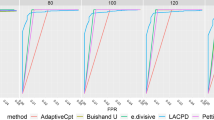Abstract
There is a great need for quantitative techniques to assess changes in water quality related to progressive watershed land-use developments, water-related impoundments or to evaluate the impact of recent sanitation programs. In choosing a physically representative variate for the water quality of the run-off, both concentrations and fluxes of pollutants must be taken into account. The importance of the climatic seasonal and hydrological factors associated with unstable event-related contributions of point and non-point pollution sources of the pollutants has lead us to simultaneously study water-discharge and pollutant flux time-series. The mass-discharge time-series are, in practice, far from being ideal for the application of classical trend analysis: they are relatively short and inaccurate: their distribution, orginating from mixed parent populations is very often highly skewed; they show a high level of serial dependence and the seasonal effects represent a large percentage of the variance, concealing possible long-term trends. Faced with the poor structure of these series which prohibits the use of statistical tests, experiments have been carried out with progressive-regressive inertial techniques, which imply the stationarity of water discharges. The double-mass technique was developed originally as a visual technique, to assess the homogeneity of precipitation records and was extended to study variations in sediment transport in modified watersheds. More recently confidence ‘rails’ and slope change detection have rendered its use more quantitative. Based on the same inertial principles, the Cumulative Sum (CUSUM) functions allow simultaneous evaluation of the covariability of the two series. An example involving weekly sampled nitrate concentrations and continuously monitored water discharges is developed.
Similar content being viewed by others
References
BallandP. and VaretG.: 1979, ‘Application des relations concentration-début à l'estimation quantitative des apports en éléments fertilisants’, La technique de l'eau et de l'assainissement 385(1), 17–31.
BensonM.: 1965, ‘Spurious Correlations in Hydraulics and Hydrology’, J. Hydraul. Div., A.S.C.E. 91(HY4), 35–52.
Bobée, B., Cluis, D., and Tessier, A.: 1977, Évaluation du réseau de qualité des eaux du Québec, Dept. Nat. Res. Report Q.E. 20, 129 p.
BoxG. E. P. and TiaoG. C.: 1975, ‘Intervention Analysis with Applications to Economic and Environmental Problems’, J. Amer. Stat. Assoc. 70(349), 70–79.
Brunet-MoretY.: 1971, ‘Étude de l'homogénéité de séries chronologiques de précipitations annuelles par la méthode des doubles-masses’, Cahiers de l'ORSTROM, Série hydrologie 8(4), 1–31.
ConoverW. J.: 1971, Practical Non-Parametric Statistics, John Wiley, New York, 449 p.
D'AstousF. and HipelK. W.: 1979, ‘Analyzing Environmental Time Series’, J. Env. Eng. Div., A.S.C.E. 105(EE5), 979–992.
Environmental Canada: 1979, Assessment of Water Quality Simulation Capability for Lake Ontario, Scientific series No. 111, 220 p.
FergusonG. A.: 1965, Non-parametric Trend Analysis, McGill University Press, Montréal, 61 p.
FosterF. G. and StuardA.: 1954, ‘Distribution-Free Tests in Time-Series Based on the Breaking of Records’, J. Roy. Stat. Soc. B 6(1), 1–22.
GoldsmithP. L. and WhitfieldH.: 1961, ‘Average Run Lengths in Cumulative Chart Quality Control Schemes’, Technometrics 3(1), 11–2.
HallF. R.: 1970, ‘Dissolved Solids-Discharge Relationships, 1. Mixing Models’, Water Resour. Res. 6(3), 845–850.
HallF. R.: 1971, ‘Dissolved Solids-Discharge Relationships, 2. Applications to Field Data’, Water Resour. Res. 7(3), 591–601.
HipelK. W., LennoxW. C., UnnyT. E., and McLeodA. I.: 1975, ‘Intervention Analysis in Water Resources’, Water Resour. Res. 11(6), 855–861.
JohnsonR. A. and BagshawM.: 1974, ‘The Effect of Serial Correlation on the Performance of CUSUM Tests’, Technometrics 16(1), 103–112.
Kartha, C. P. and Abraham, B.: 1979, ARL for CUSUM Charts with Correlated Observations, ASQC techn. conf. trans. Houston, pp. 751–755.
KeepingE. S.: 1966, ‘Distribution Free Methods in Statistics’, in Statistical Methods in Hydrology, Symposium No. 5, 211–247, Inland Water Branch, Dept. of Mines, Energy and Resources, Canada.
KohlerM. A.: 1949, ‘On the Use of Double-Mass Analysis for testing the Consistency of Meteorological Records and for Making Required Adjustments’, Bull. Ann. Meteol. Soc. 30, 188–189.
LettenmaierD. P.: 1976, ‘Detection of Trends in Water Quality Data from Records with Dependent Observations’, Water Resour. Res. 12(5), 1037–1046.
LettenmaierD. P.: 1977, Detection of Trends in Stream Quality: Monitoring Network Design and Data Analysis, Ch. W. Harris Hydraulics laboratory, Tech. Report No. 51, Seattle, Wash., 166 p.
ManczakH. and FlorczykP.: 1971, ‘Interpretation of Results from the Studies of Pollution of Surface Flowing Waters’, Water. Res. 5(8), 575–584.
Searcy, J. K. and Hardison, C. H.: 1960, ‘Double-Mass Curves’, U.S.G.S. Water Supply Paper 1541-B, 66 p.
Sherwani, J. K. and Moreau, D. H.: 1975, Strategies for Water Quality Monitoring, Water Resources Research Institute, Un. of N. Carolina, Report No. 107, 137 p.
TinM.: 1965, ‘Comparison of Some Ratio Estimators’, J. Amer. Statist. Ass. 60, 294.
VanDobben DebruynC. S.: 1968. Cumulative Sum Tests: Theory and Practice, Griffin's Statistical Monographs and Courses, No. 24, Hafner Publ. Co., New York, N.Y.
WeberH., CluisD., and BobéeB.: 1969, ‘Accuracy Evaluation in the Calculation of Mass-Discharges’, J. Hydrol. 40, 175–184.
WeissL. L. and WilsonW. T.: 1953, ‘Evaluation of Significance of Slope Changes in Double-Mass Curves’, Trans. Am. Geophys. Union. 34(6), 893–896.
Yevjevich, V. and Jeng, R. I.: 1969, Properties of Non-Homogeneous Hydrologic Series, Colorado State Univ., Hvdrology Paper No. 32, 33 p.
Author information
Authors and Affiliations
Rights and permissions
About this article
Cite this article
Cluis, D.A. Visual techniques for the detection of water quality trends: Double-mass curves and cusum functions. Environ Monit Assess 3, 173–184 (1983). https://doi.org/10.1007/BF00398846
Received:
Revised:
Issue Date:
DOI: https://doi.org/10.1007/BF00398846




